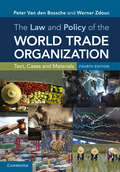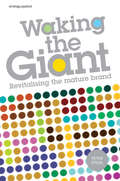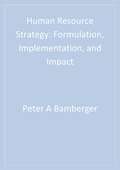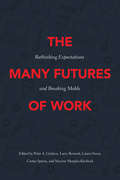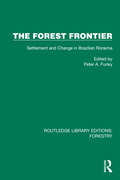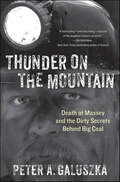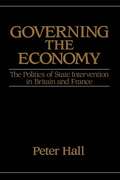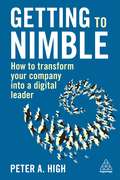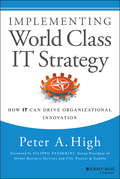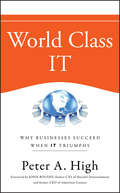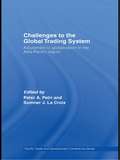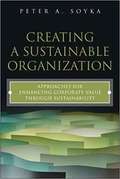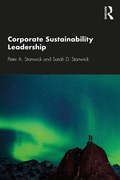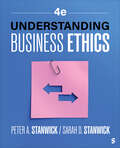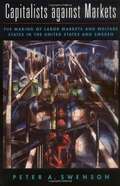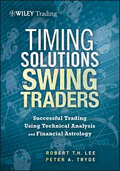- Table View
- List View
The Law and Policy of the World Trade Organization: Text, Cases and Materials
by Peter Werner Zdouc Van Den BosscheSince its first edition, this textbook has been the first choice of teachers and students alike, due to its clear introduction to the basic principles of the multilateral trading system and its detailed examination of the law of the World Trade Organization. The third edition continues to explore the institutional and substantive law of the WTO. Material has been restructured to closely align with teaching approaches making it even more user-friendly. It has been updated to incorporate all new developments in the WTO's body of case law. Questions and assignments are integrated to allow students to assess their understanding, while chapter summaries reinforce learning. Chapters end with an exercise reflecting real-life trade problems: these challenge students (and practitioners) and enable them to hone their analytical skills. This title is an essential tool for all WTO law students and will also serve as the practitioner's introductory guide to the WTO.
Waking the Giant
by Peter SteidlBrand maturity is not inevitable. Waking the Giant challenges current thinking and practice when it comes to achieving growth with mature brands. This book convincingly demonstrates that the challenge of revitalising a mature brand is just as exciting -- and requires just as much ingenuity and innovation -- as launching a new brand. While major mature brands still dominate many categories, margins and growth opportunities are often less than exciting. The critical question is: milk the brand, or revitalise? And, just as important: is your organisation fully committed to, and able to deliver on, your chosen strategy? Inside you'll discover: the merits of revitalisation and milking strategies, and how to choose between them how to renew positive differentiation for a mature brand how to implement a revitalisation strategy and eliminate outdated work practices that could ruin your plan how to align your revitalisation strategy with the consumers' and industry sector's evolutionary trends.
Human Resource Strategy: Formulation, Implementation, and Impact
by Peter A. Bamberger Professor Ilan MeshoulamHuman Resource Strategy provides an overview of the academic and practitioner responses to these and other questions. Applying an integrative framework, the authors review twenty years' worth of empirical and theoretical research in an attempt to reconcile often-conflicting conceptual models and competing empirical results. The authors present much of the relevant research in the context of the critical strategic decisions that executives must actually make with regard to human resource investments and deployments. As a result, often complex theoretical models and scientific findings are presented such that they are not only understandable but also highly relevant to non-research-oriented practitioners.
Cork'd: Building a Social Network for Wine Lovers
by Peter A. ColesLindsay Ronga and Gary Vaynerchuk are launching Cork'd, an online social network for wine lovers. Despite Gary's status as a celebrity wine connoisseur, the team faces a significant challenge: several other wine social networks are well established and already have large user bases. How can Cork'd gain traction in this crowded space?
The Many Futures of Work: Rethinking Expectations and Breaking Molds
by Peter A. Creticos, Larry Bennett, Laura Owen, Costas Spirou, And Maxine Morphis-RiesbeckWhat will work eventually look like? This is the question at the heart of this timely collection. The editors and contributors—a mix of policy experts, academics, and advocates—seek to reframe the typical projections of the “future” of work. They examine the impact of structural racism on work, the loss of family‑sustaining jobs, the new role of gig work, growing economic inequality, barriers to rewarding employment such as age, gender, disability, and immigration status, and the business policies driving these ongoing challenges. Together the essays present varied and practical insights into both U.S. and global trends, discuss the role of labor activism in furthering economic justice, and examine progressive strategies to improve the experience of work, wages, and the lives of workers. The Many Futures of Work offers a range of viable policies and practices that can promote rewarding employment and steer our course away from low-wage, unstable jobs toward jobs that lead to equitable prosperity and economic inclusion.
Saving Social Security: A Balanced Approach
by Peter A. Diamond Peter R. OrszagDiscusses options for addressing the problems facing the Social Security program.
The Forest Frontier: Settlement and Change in Brazilian Roraima (Routledge Library Editions: Forestry)
by Peter A. FurleyOriginally published in 1994, this book analysed land developments, deforestation and pasture substitution, colonisation schemes and spontaneous settlement during the latter part of the 20th Century. In so doing, The Forest Frontier presents an overview of the intrinsic environmental and socio-economic resources of the Roraima, the most northerly of the Brazilian Amazon states. Roraima is of special environmental interest because of its extensive savannas and varied forests – the home of some of the largest and most diverse groups of indigenous Indians. This critical assessment of the nature and pace of agricultural advance into Roraima examines the range of strategies which have been proposed to cope with the inevitable development. With the conflict between preserving the natural environment and development still major issues for Brazil, this book remains as relevant now as when it was first published.
The Gravity Model in International Trade: Advances and Applications
by Steven Brakman Peter A. G. van BergeijkHow do borders affect trade? Are cultural and institutional differences important for trade? Is environmental policy relevant to trade? How does one's income or wage relate to the fact that trade partners are nearby or far away? These are just some of the important questions that can be answered using the gravity model of international trade. This model predicts and explains bilateral trade flows in terms of the economic size and distance between trading partners (e. g. states, regions, countries, trading blocs). In recent years, there has been a surge of interest in this model and it is now one of the most widely applied tools in applied international economics. This book traces the history of the gravity model and takes stock of recent methodological and theoretical advances, including new approximations for multilateral trade resistance, insightful analyses of the measurement of economic distance and analyses of foreign direct investment.
Thunder on the Mountain: Death at Massey and the Dirty Secrets Behind Big Coal
by Peter A. Galuszka"Scathing exposé of the coal industry."--The New York Times Book ReviewOn April 5, 2010, an explosion ripped through Massey Energy's Upper Big Branch Mine, killing twenty-nine coal miners. This tragedy was the deadliest mine disaster in the United States in forty years—a disaster that never should have happened. These deaths were rooted in the cynical corporate culture of Massey and its notorious former CEO Don Blankenship, and were part of an endless cycle of poverty, exploitation, and environmental abuse that has dominated the Appalachian coalfields since coal was first discovered there. And the cycle continues unabated as coal companies bury the most insidious dangers deep underground, all in search of higher profits, and hide the true costs from regulators, unions, and investors alike.But the disaster at Upper Big Branch goes beyond the coalfields of West Virginia. It casts a global shadow, calling into bitter question why coal miners in the United States are sacrificed to erect cities on the other side of the world, why the coal wars have been allowed to rage, polarizing the country, and how the world's voracious appetite for energy is satisfied at such horrendous cost.With Thunder on the Mountain, Peter A. Galuszka pieces together the true story of greed and negligence behind the tragedy at the Upper Big Branch Mine, and in doing so he has created a devastating portrait of an entire industry that exposes the coal-black motivations that led to the death of twenty-nine miners and fuel the ongoing war for the world's energy future.
Governing the Economy: The Politics of State Intervention in Britain and France (Europe And The International Order Ser.)
by Peter A. HallFor over one hundred years, the British economy has been in decline relative to other industrialized countries. <p><p>This book explores the origins of Britain's economic problems and develops a striking new argument about the sources of decline. It goes on to analyze the evolution of economic policy in postwar Britain from the development of Keynesianism to the rise of monetarism under Margaret Thatcher. France, by contrast, experienced an economic miracle in the postwar period. <p><p>Hall argues that the French state transformed itself and then its society through an extensive system of state intervention. In the recent period, however, the French system has encountered many difficulties, and the book locates their sources in the complex interaction between state and society in France culminating in the socialist experiment of Francois Mitterrand. <p><p>Through his insightful, comparative examination of policy-making in Britain and France, Hall develops a new approach to state-society relations that emphasizes the crucial role of institutional structures.
The Political Power of Economic Ideas: Keynesianism across Nations
by Peter A. HallJohn Maynard Keynes once observed that the "ideas of economists and political philosophers, both when they are right and when they are wrong, are more powerful than is commonly understood." The contributors to this volume take that assertion seriously. In a full-scale study of the impact of Keynesian doctrines across nations, their essays trace the reception accorded Keynesian ideas, initially during the 1930s and then in the years after World War II, in a wide range of nations, including Britain, the United States, France, Germany, Italy, Japan, and Scandinavia. The contributors review the latest historical evidence to explain why some nations embraced Keynesian policies while others did not. At a time of growing interest in comparative public policy-making, they examine the central issue of how and why particular ideas acquire influence over policy and politics. Based on three years of collaborative research for the Social Science Research Council, the volume takes up central themes in contemporary economics, political science, and history. The contributors are Christopher S. Allen, Marcello de Cecco, Peter Alexis Gourevitch, Eleanor M. Hadley, Peter A. Hall, Albert O. Hirschman, Harold James, Bradford A. Lee, Jukka Pekkarinen, Pierre Rosanvallon, Walter S. Salant, Margaret Weir, and Donald Winch.
Getting to Nimble: How to Transform Your Company into a Digital Leader
by Peter A. HighWith increased pressure from digital natives, now is the time for established companies to address outdated and antiquated practices in order to respond quickly to the ever-increasing speed of market changes. The pace of change in business today is such that it is becoming easier to go from a legendarily high-performing company to liquidation in a short period of time. Getting to Nimble shares the stories of organizations that were able to successfully transform their people practices, processes, technology, ecosystems and strategy for the digital era. The book also covers once dominant companies like Circuit City and Kodak that neglected to change and were impaired or died as a result.Highlighting a framework to follow along with best practices that others can emulate, Getting to Nimble includes case studies from major organizations such as Capital One, FedEx, CarMax, The Washington Post, Domino's Pizza, Walmart and the country of Estonia.
Implementing World Class IT Strategy
by Peter A. HighThe actionable guide for driving organizational innovation through better IT strategyWith rare insight, expert technology strategist Peter High emphasizes the acute need for IT strategy to be developed not in a vacuum, but in concert with the broader organizational strategy. This approach focuses the development of technology tools and strategies in a way that is comprehensive in nature and designed with the concept of value in mind. The role of CIO is no longer "just" to manage IT strategy--instead, the successful executive will be firmly in tune with corporate strategy and a driver of a technology strategy that is woven into overall business objectives at the enterprise and business unit levels.High makes use of case examples from leading companies to illustrate the various ways that IT infrastructure strategy can be developed, not just to fall in line with business strategy, but to actually drive that strategy in a meaningful way. His ideas are designed to provide real, actionable steps for CIOs that both increase the executive's value to the organization and unite business and IT in a manner that produces highly-successful outcomes.Formulate clearer and better IT strategic plansWeave IT strategy into business strategy at the corporate and business unit levelsCraft an infrastructure that aligns with C-suite strategyClose the gap that exists between IT leaders and business leadersWhile function, innovation, and design remain key elements to the development and management of IT infrastructure and operations, CIOs must now think beyond their primary purview and recognize the value their strategies and initiatives will create for the organization. With Implementing World Class IT Strategy, the roadmap to strategic IT excellence awaits.
World Class IT
by Peter A. HighWorld Class ITWhy Businesses Succeed When IT TriumphsPeter A. HighForeword by John Boushy, former CIO of Harrah's Entertainment and former CEO of Ameristar CasinosPraise for World Class IT"Technology and business leaders alike must understand how to use IT to their advantage. Today, all businesses are technology companies powered by people; it is simply a question of degree. Failure to understand this and to harness technology to a company's advantage will result in one's company being a follower in an industry as opposed to a shaper of it. In World Class IT, Peter High distills the key principles for business and IT leaders to follow to ensure that your company is a leader rather than a laggard."-Robert Willett, CEO, Best Buy International"World Class IT taps the experience and advice of the world's greatest thinkers in corporate technology and marries it with a simple, yet powerful working framework. Peter's access to the best-of-the-best CIOs and his ability to boil their learnings down to the essentials is invaluable."-Gregor Bailar, former chief information officer, Capital One, and former chief information officer, NASDAQ"Peter High has made a valuable, highly practical, and rigorous contribution to principles-based IT resource management. Peter has observed accomplished CIOs transforming IT management in their organizations from narrow 'spectator support' for their senior management teams to a 'participative sport' resulting in a strategic IT asset. This is an important read for CIOs and their IT management teams."-Richard Nolan, the Philip M. Condit Endowed Chair in Business Administration at the University of Washington, Foster School of Business, and the William Barclay Harding Professor of Business Administration at the Harvard Business School (emeritus)"Peter High has uncovered and illuminated important principles that are relevant to any IT executive. We find that many of our most successful IT strategies are reflected in his framework, and I certainly learned from his research, as well."-Randy Spratt, executive vice president, chief information officer, and chief technology officer, McKesson"Following the principles and subprinciples of World Class IT offers invaluable insights and will improve performance no matter the company."-Tim Harvey, former executive vice president of shared services and chief information officer, Hilton Hotels Corporation
Transforming Private Landlords: Housing, Markets and Public Policy (Real Estate Issues Ser. #52)
by Tony Crook Peter A. KempThis book explores the origins, extent and implications of this revival in the fortunes of private landlordism. It presents an in-depth, scholarly analysis of private landlords, the rationales for and ways in which governments have sought to revitalise investment in residential lettings, and their success in doing so. It also assesses the extent to which landlordism has been transformed in recent years and the lessons for policy that can be learned from this experience. The book draws on the extensive research into private landlords conducted by the authors over the past two decades. This includes projects funded by the Joseph Rowntree Foundation, the predecessor departments to the Department for Communities and Local Government, Scottish Homes, and the Economic and Social Research Council. It fills a major gap in the literature about an important actor in housing provision and the built environment. Most of the recent work on private landlords has been published as research reports and there is a lack of book length scholarly study aimed at an academic rather than a policy audience.
Challenges to the Global Trading System: Adjustment to Globalization in the Asia-Pacific Region (PAFTAD (Pacific Trade and Development Conference Series))
by Peter A. Petri Sumner J. La CroixInternational trade continues to expand robustly in East Asia and elsewhere, but global trade negotiations have collapsed and globalization is widely criticized. In this book, the participants of the thirtieth Pacific Trade and Development Conference—including the then-Director General of the World Trade Organization, and leading government officials, academics and executives from a dozen major Pacific Rim economies—debate whether global negotiations have ended once and for all, or are suffering temporarily from ‘globalization fatigue;’ whether East Asia’s new regional partnerships will advance or undermine the global trading system; and whether the region’s trade tensions with the United States will intensify or subside. They provide new empirical evidence on how trade affects the distribution of income, the location of pollution-intensive industries, the causes of ‘outsourcing,’ the structure of the intellectual property regime, and international security. And they probe the implications of adjustment to globalization: how can countries reap the benefits of trade while controlling the risks faced by the poor and, perhaps more importantly, the politically strong? Challenges to the Global Trading System is an invaluable resource for students and scholars of Asia-Pacific studies, international relations and development studies, as well as those with a more general interest in Asian studies.
Creating a Sustainable Organization: Approaches for Enhancing Corporate Value Through Sustainability
by Peter A. SoykaOrganizations that prioritize environmental, health, and safety (EHS) issues are well placed to attract better customers, better talent, and today's growing number of socially responsible investors. But, to gain these benefits, companies must choose the right sustainability strategies, and then manage and measure them well. Now, leading business sustainability consultant Peter Soyka offers a complete and actionable guide to driving greater value through sustainability. In Creating a Sustainable Organization, Soyka bridges the disparate worlds of the EHS/sustainability professional and the investor/analyst. Readers will learn what the evidence says about linkages between sustainability and value… how to manage key stakeholder relationships influencing corporate response to EHS and social equity issues… how to effectively manage sustainability throughout the business… how to evaluate sustainability posture and performance from the standpoint of external investors and internal management… how to maximize the influence of organizational actors focused on sustainability, and much more. This book will be invaluable for all environmental, health, and safety decision-makers and professionals concerned with improving sustainability and value; for executives and strategists seeking long-term competitive advantage; for stock analysts evaluating potential investments; and for researchers and MBA candidates currently studying the techniques and potential of corporate sustainability.
Corporate Sustainability Leadership
by Peter A. Stanwick Sarah D. StanwickCorporate sustainability, now regarded as a vitally important topic on the agenda for businesses, has in recent years not only become embedded in postgraduate study, but is now also widely taught at the undergraduate level in business schools. Corporate Sustainability Leadership reflects the growing need for an accessible text at all levels of study. The book brings the topic of corporate sustainability fully up to date by incorporating new directions in the areas of corporate responsibility and sustainability. Written by the authors of the highly successful Understanding Business Ethics, this book provides a primary resource for any undergraduate or graduate corporate sustainability class. Unlike other textbooks in corporate sustainability, which are often edited collections from multiple authors, this book develops themes throughout each chapter using a consistent voice to ensure an integrative learning experience for both students and instructors. With ten chapters and ten cases, all of which are supplemented with online test banks, instructor guides, and PowerPoint slides, this textbook provides enough content for a complete class on corporate sustainability. Using stakeholder theory as a foundation, Corporate Sustainability Leadership allows readers to develop a better understanding of how organizations can effectively satisfy the needs of their critical stakeholders. It addresses the issues of corporate sustainability from both a micro and macro perspective. Micro issues related to corporate sustainability include leadership, organizational change, management decision making, human resource organizational strategies, organizational ethics, organizational culture, corporate sustainability reporting, corporate sustainability performance, and corporate compliance. The macro issues addressed include suppliers, corporate sustainability communications, consumers, the natural environment, governments, NGOs, and the developing world. In addition, there are ten unique company cases from organizations that are household names, such as Bayer, Shell, Volkswagen, and Dow Chemical.
Understanding Business Ethics
by Peter A. Stanwick Sarah D. StanwickUnderstanding Business Ethics, Fourth Edition offers an impactful exploration into the realm of ethics in the global business environment. Authors Peter A. Stanwick and Sarah D. Stanwick integrate four key dimensions to differentiate their work from other ethics textbooks: a global perspective, real-world business cases, comprehensive ethics topics, and a consistent theme linking each chapter. Whether it′s uncovering the intricate relations between businesses and their stakeholders, discussing the effects of financial reporting, or exploring the ethical implications of information technology, marketing, human resources, and the natural environment, this textbook equips readers with a robust ethical framework for the business world. Additionally, the timely case studies from diverse industries demonstrate the very real consequences of ethical and unethical decisions. This text is offered in Sage Vantage, an intuitive learning platform that integrates quality Sage textbook content with assignable multimedia activities and auto-graded assessments to drive student engagement and ensure accountability. Unparalleled in its ease of use and built for dynamic teaching and learning, Vantage offers customizable LMS integration and best-in-class support. Watch this video walkthrough and see how Vantage works:
Understanding Business Ethics
by Peter A. Stanwick Sarah D. StanwickUnderstanding Business Ethics, Fourth Edition offers an impactful exploration into the realm of ethics in the global business environment. Authors Peter A. Stanwick and Sarah D. Stanwick integrate four key dimensions to differentiate their work from other ethics textbooks: a global perspective, real-world business cases, comprehensive ethics topics, and a consistent theme linking each chapter. Whether it′s uncovering the intricate relations between businesses and their stakeholders, discussing the effects of financial reporting, or exploring the ethical implications of information technology, marketing, human resources, and the natural environment, this textbook equips readers with a robust ethical framework for the business world. Additionally, the timely case studies from diverse industries demonstrate the very real consequences of ethical and unethical decisions. This text is offered in Sage Vantage, an intuitive learning platform that integrates quality Sage textbook content with assignable multimedia activities and auto-graded assessments to drive student engagement and ensure accountability. Unparalleled in its ease of use and built for dynamic teaching and learning, Vantage offers customizable LMS integration and best-in-class support. Watch this video walkthrough and see how Vantage works:
Capitalists Against Markets: The Making Of Labor Markets And Welfare States In The United States And Sweden
by Peter A. SwensonConventional wisdom argues that welfare state builders in the US and Sweden in the 1930s took their cues from labor and labor movements. Swenson makes the startling argument that pragmatic social reformers looked for support not only from below but also from above, taking into account capitalist interests and preferences. Juxtaposing two widely recognized extremes of welfare, the US and Sweden, Swenson shows that employer interests played a role in welfare state development in both countries.
Timing Solutions for Swing Traders
by Robert T.H. Lee Peter A. TrydeA unique new approach to trading based on financial analysis and financial astrology Timing Solutions for Swing Traders: Successful Trading Using Technical Analysis and Financial Astrology is a remarkable new book that introduces a revolutionary approach to non-day trading that combines the four basic dimensions of trend analysis--price patterns, volume, price momentum, and price moving averages--with a little financial astrology. Focusing on the essentials of technical analysis, the book is filled with examples of reliable indicators and formulas that traders can use to help develop their own styles of trading, specially tailored to their individual needs and interests. Filled with real-life market examples to help you understand how to use the matrix of moving averages, how to apply different sets of time frame moving averages to form a trading decision, and how to determine the intermediate state of the market using the Queuing Theory (QMAC)--which dissects the interplay of long-term moving averages and helps anticipate major support and resistance levels--this book is packed with the information you need to maximize your trading potential. A dedicated trading guide for non-day traders Incorporates examples and formulas to bring ideas to life Presents an innovative new approach to trading that draws on the four core dimensions--price patterns, volume, price momentum, and price moving averages--for analyzing trends Innovative and practical, Timing Solutions for Swing Traders is a hands-on guide to applying a remarkable new approach to trading.
Balancing Liberty and the Pursuit of Well-Being: What Can Be Done about the Free Market's Tendency to Exploit Human Weakness?
by Peter A. UbelAccording to behavioral scientist and physician Peter Ubel, we humans are not as rational as some libertarians would have us believe, and, therefore, the free market often puts us in a position to harm ourselves. To make matters worse, the free market often rewards those people who understand consumer behavior well enough to exploit our weaknesses. Because the free market fails to protect consumer interests, a good government should find appropriate ways to protect us from ourselves. But figuring out how to balance our desire for freedom with the pursuit of happiness is no easy task. This chapter is excerpted from "Free Market Madness: Why Human Nature Is at Odds with Economics--and Why It Matters."
Bank Tellers, Fighter Pilots, and the Limits of Rationality: The Origins of Behavioral Economics
by Peter A. UbelMuch of economic theory has revolved around the age-old assumption that humans make choices rationally and based on probability, or what we have learned from previous experience. Free markets operate under this assumption, even going so far as to frame the obesity epidemic as the result of personal choices made by rational individuals. In this chapter, physician and behavioral scientist Peter Ubel explores the origins of behavioral economics, which challenges the assumption that humans always act in their own best interest. This chapter is excerpted from "Free Market Madness: Why Human Nature Is at Odds with Economics--and Why It Matters."
Can Government Combat Obesity Without Becoming a "Nanny State"?: Personal Freedom and Personal Well-Being Don't Have to Be Mutually Exclusive
by Peter A. UbelPolitical extremists of all persuasions are often paranoid about the slippery slope, worrying that any tiny concessions they make will lead to complete absolution of their position. Free market enthusiasts would rather have a fat and free citizenry, for instance, than consider perceived interventions into personal liberties, even if those interventions are made on behalf of the health of the general public. In this chapter, behavioral scientist and physician Peter Ubel considers whether or not a middle ground exists in the argument between liberty and personal well-being. He explores what governments can do to combat obesity, from the win-win solutions promoted by soft paternalists, to more intrusive alternatives. This chapter is excerpted from "Free Market Madness: Why Human Nature Is at Odds with Economics--and Why It Matters."
